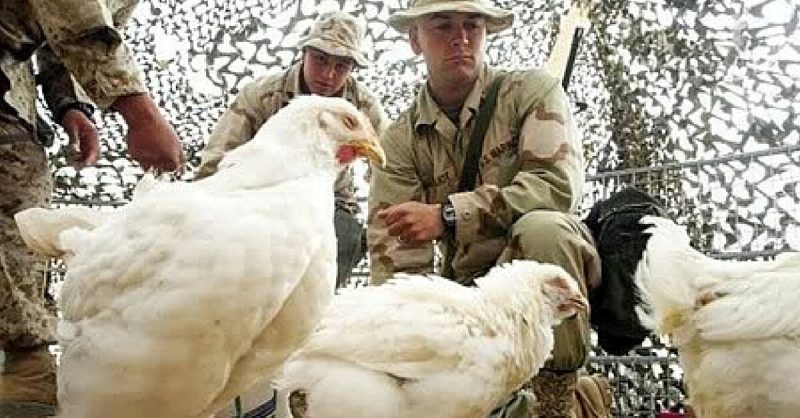A century and a half ago, it was common to use birds as detectors of poison and poison gases. Because of their delicate lungs and how their lungs are arranged, birds will show signs of respiratory distress or even death before a human will know that anything is amiss.
So it was that canaries came to be used as alarm systems for mine workers so that if they exposed trapped gas or other life-threatening pollutants, the canaries would let them know that death was knocking.
Using the same logic, the US military decided to enlist chickens for the first Gulf War. In the half decade leading up to that war, the DOD had convinced itself that biological warfare wasn’t a threat. Perhaps that’s why only 7% of the biological and chemical warfare R&D funds were used to find ways to detect biological agents.
This left them with virtually no way to detect biological weapons when Operation Desert Storm went into effect. All they had was the old canary theory, so in marched the chickens.
Their official designation in the Marine Corps was “Poultry Chemical Confirmation Devices.” The focused use of poultry pawns in both Gulf Wars was referred to as Operation Kuwaiti Field Chicken. Yes, that’s “KFC”.
Once enlisted, the chickens of the first Gulf War stood sentinel outside camps. Unlike technology based gas detectors, the organic nature of the chickens held a caveat: one morning, when some soldiers woke up and emerged from their tents, they saw all of the chickens lying dead on the ground.
The soldiers were naturally terrified that they had been gassed, but it turned out the chickens had frozen overnight in the cold. This shows that the plan had validity, though. Had the chickens actually died of the poison, the soldiers may have had time to get away and to seek medical help. The chickens proved a welcome addition to that evenings dinner.
Because PCCD were living and therefore not easily manageable as military equipment and gear, the DOD finally invested in defense contractor help in 1990. At that time, they began using Individual Chemical Agent Detectors – of the manmade variety. Who knows what happened between then and 2003, but when the second Gulf War hit – it was back to the chickens.
In the first year of Operation Iraqi Freedom, 43 chickens were purchased to be used as KFC PCCD. The idea was that the chickens would ride atop military vehicles in lookout cages. If the chickens dropped dead, it was time to turn about and retreat. The problem was, they died before the operation even got off the ground.
In an interview by The Saint Louis Dispatch, Sgt. Ken Griffin said, “Nobody knows why they died. I just heard that they were boxed up really tight when they arrived, and they started dying from the moment they got here. And it didn’t help that nobody here really knows anything about chickens.”
Another officer, Chief Warrant Officer Ken King was responsible for saving the two that didn’t die. It was his theory that chickens are used to pecking at dirt and “. . . we’ve only got sand. So they were pecking the sand and getting it all clogged up in the giblets or nostrils or whatever.”
Out of the 43 chickens brought to Kuwait, 41 died. These brave little soldiers were given a nice burial, complete with wooden tombstones bearing their names: Captain Popeye, PFC King, Lance Cpl. Pecker, and the grave of The Unknown Chicken.
While the chickens as gas detectors idea didn’t exactly work out, chickens served successfully in another military function. They were used in the research of Gulf War Syndrome, its effects, and possible treatments.
